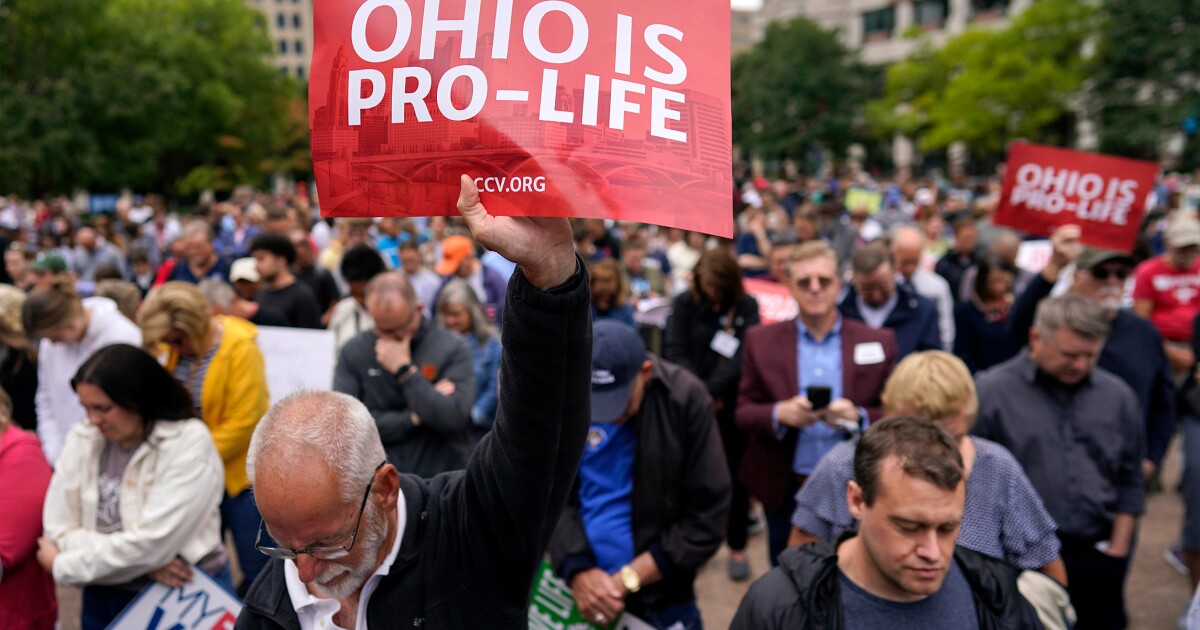

Ohio voters will decide on Nov. 7 whether abortion should be enshrined as a constitutional right in their state, the second time they will weigh in on the matter in less than three months. It will offer a road map of the political landscape in 2024, when more state-level abortion-related ballot measures are expected to come before voters.
In August, a precursor Ohio ballot initiative sponsored by anti-abortion advocates went down to defeat. The proposal would have raised the threshold for passing state constitutional amendments from 50% to 60%, but the abortion rights community was galvanized to defeat it.
THIRD-PARTY CANDIDATES WHO HAVE DERAILED PAST PRESIDENTIAL CAMPAIGNS
Now, its successor, the looming Ohio Issue 1, would establish a state constitutional right to “make and carry out one’s own reproductive decisions.” That includes decisions about abortion, contraception, fertility treatment, miscarriage care, and continuation of pregnancy. The amendment would also prevent the state from acting to “directly or indirectly burden, penalize, prohibit, interfere with, or discriminate against” a citizen’s reproductive choices.
It has turned into one of the fall’s fiercest political battles.
“All eyes are on Ohio,” Jeanne Mancini of March for Life told the Washington Examiner. The Buckeye State has been the epicenter of the state-level debate on abortion since supporters of the procedure proposed an amendment to the state constitution enshrining reproductive rights earlier this year.
Since the Supreme Court overturned Roe v. Wade, effectively eliminating federal protections on abortion, all 50 states have acted in some capacity to limit or preserve abortion rights.
Quintessential swing states, such as Michigan, have joined Democratic-majority states in instituting strong abortion rights amendments. Kansas also adopted an abortion rights amendment into its constitution, shaking social conservatives.
Other strong Republican states, including Kentucky and Montana, rejected amendments that would have constitutionally constrained abortion. So far, at least eight other states — Florida, Arizona, and South Dakota, among others — are weighing abortion amendments for the 2024 election cycle, making Ohio’s vote a harbinger of things to come.
“It’s the first of many ballot initiatives in the next cycle,” Mancini said. “What we’re seeing is some of these pro-life states are moving far to the left of what [Roe v. Wade] would allow through these ballot initiatives.”
Part of Mancini’s concern is that abortion rights amendments turn what should be a matter of legislative policy into a matter of broad-based constitutional authority.
“It’s really moving what I think should be a policy debate and process out of the hands of the people,” Mancini noted. “It’s true that people, yes, are voting, but they’re not voting for candidates. What they’re voting for is language that is often vague and confusing … and these are very expansive, so they’re not your traditional policymaking mechanism.”
Amendment on the Unborn
Critics of the amendment note the state can limit access to abortion after viability, which can begin as early as 22 weeks gestation. But the final decision to abort even past viability rests with a woman and her physician if continuing the pregnancy is deemed dangerous to the physical or mental health of the mother.
Further, because the amendment would be part of the state constitution, it would supersede existing state laws. This includes a six-week gestational limit that is currently blocked by court order. The amendment would also nullify existing regulations on abortion facilities, as well as parental consent requirements for abortions performed on minors.
Protect Women Ohio, a coalition of anti-abortion voices opposed to Issue 1, has stressed through its ad campaigns that the amendment is anti-parent because of its implicit nullification of parental consent notifications. But Ohioans United for Reproductive Rights says that characterization is inaccurate.
“Anti-parent? Wrong,” Gabriel Mann of OURR told the Washington Examiner. “As a husband and a father, I’m supporting Issue 1. Voting ‘yes’ on Issue 1 will stop this abortion ban and put Ohioans back in charge of our families’ personal medical decisions.”
How the proposed amendment will be described on the ballot is a large part of the political fracas leading up to the Nov. 7 vote. Republican Secretary of State Frank LaRose, a Senate candidate for 2024, wrote a ballot summary that replaced the medical terms “zygote” and “fetus” with “unborn child.”
OURR contended in a lawsuit against the summary that the language “unnecessarily introduces an ethical judgment.” But the Ohio Supreme Court disagreed last month, saying that it did not interpret the ballot summary as undue persuasion of the voters.
Summer of Discontent
Anti-abortion Ohioans suffered a steep loss for their cause over the summer during that special election that would have made it more difficult to pass state constitutional amendments. At issue on Aug. 8 was whether or not to increase the threshold of ballot initiatives to a 60% majority to pass — a measure that pro-abortion rights groups said was an elimination of the “one-man, one-vote” principle and a threat to democracy.
Once a swing state in presidential contests, Ohio now tilts decisively toward Republicans, but with a populist twist. Former President Donald Trump twice won Ohio by about 8 percentage points, and its congressional delegation and state government are GOP-dominated.
Anti-abortion advocates contend that the strong labor union influence, especially in the heavily industrial northeastern Ohio, in part triggered the loss. They say that won’t be a problem this time.
“There were a lot of different ways to think about it in August, and it was never about abortion,” said Amy Natoce of Protect Women Ohio, the coalition of anti-abortion groups against Issue 1. “This November is very different. It says very clearly it is about extreme abortion, women’s health, and protecting the unborn.”
Natoce added, “It was hard to define in August. It’s defined in November. People know what is at stake. They know what they’re going out and voting for.”
Susan B. Anthony Pro-Life America, one of the nation’s largest anti-abortion organizations, said in the aftermath of the August vote that the Republican Party of Ohio failed to market the matter appropriately, resulting in ads coming in too late to affect early voting. Natoce confirmed that her organization would not make the same mistake, having already flooded the airwaves with anti-amendment content.
Both sides have spent a combined total of nearly $25 million, with the anti-abortion lobby spending nearly $4 million more than supporters of Issue 1.
Early voting in Ohio started on Oct. 11. The weekend before, over 5,000 Ohioans gathered in the capital on Oct. 6 to hear religious leaders such as Bishop of Columbus Earl Fernandes and conservative figures such as Sen. J.D. Vance (R-OH) at the second annual Ohio March for Life.
CLICK HERE TO READ MORE FROM THE WASHINGTON EXAMINER
Mancini told the Washington Examiner ahead of the march that the event was scheduled before the successful placement of the amendment on the ballot, making it a fortuitous coincidence.
“We will do everything we can possibly do [at the march] to rally the grassroots in Ohio to pro-life grassroots and motivate, motivate, motivate so that people will get out and vote to protect the culture of life in Ohio,” Mancini said.





